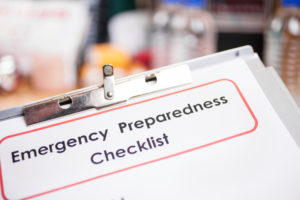Natural disasters disrupt business. It is not surprising; after all, natural disasters have cost the global economy roughly $2.5 trillion since the year 2000. Logistics and shipping functions are disproportionately affected by most of these disasters, in large part due to limited access to affected areas and damage to roadway infrastructure.
Here at Copper Peak, we make having a disaster and business continuity plan a priority, allowing us to be prepared for when something bad happens. The North Bay fires that hit last October were just such an event. How quickly the fires spread was completely unexpected, causing total devastation in their path. As the initial morning unfolded, we took comfort in knowing we had a plan. Closing the first day of the fire was inevitable, but were back up the next day and remained operational at a time when most businesses faced significant shutdown time.
It was particularly important for us to be rock steady for our clients. The fires occurred right at the beginning of the busy season when DTC shipping peaks for the year. Copper Peak remained operational, allowing our clients to continue to submit orders to us and keep revenue coming in when their facilities were closed to the public and tourism ceased. Customers around the world saw what was happening, but when their wine shipments arrived on time it diminished some of their concerns and reassured them the wine country would get through it.
It was not one thing in particular, but a series of things that allowed us to keep packages moving. The planning, preparation, and testing we had done over the years paid off. We understand that, especially with the wildfires, disaster preparedness is now on everyone’s mind. In fact, the Direct to Consumer Wine Symposium (DTCWS) had a CEO Roundtable on managing sudden challenges in your business and pointed to “agile problem solving” for short and long-term success. We thought it appropriate to share some of the things that helped Copper Peak persevere during this difficult time:
Have a documented plan. This may sound so obvious, but many businesses do not have one. We view it just like our insurance policies, it is a cost of doing business, and you hope you never have to use them. Because every organization is different, what needs to be addressed in such a plan is unique, but the common thread is having a thoroughly documented disaster plan that is shared with everyone is a necessity. Then test it when you don’t need it, like any good sports team that practices over and over again for game day.
Good people. Of course, hiring good people goes well beyond a disaster plan. It is worth emphasizing, however, how important it is to have people with the right ingrained qualities so they can help your organization navigate during disasters. This means having people who are truly dedicated to their company, their mission, and their clients or customers. People who can communicate, who can navigate changes in routine, and who do not take no for an answer. We have those type of individuals working for us, and our employee tenure is a great testimony to our team and our organization. We are extremely proud of the people we have working for us!
A client communications plan. Clients will want and need to know how the events they see on the news will affect business. We were very proactive when it came to updating our clients, using eBlast to let them know what was going on before they had a chance to wonder. We made contact with small parcel carriers to understand how they had also been affected and added this information to our correspondences so a more complete logistics picture could be given to our clients. Our clients, in turn, were able to share this information with their customers in a timely manner.
An internal communications plan. How are executives and key decision-makers updated and briefed? How are employees informed and mobilized? We had already thought a lot about these questions and had the phone and email chain working. Thankfully, everyone at CPL was able to access a cell phone signal and/or an internet connection. Another lesson learned was having alternative communication plans – think Twitter and Facebook – these were invaluable tools for real-time information. Does your company have a presence on social media?
Backup systems. If a disaster affects your facilities, you will need a way to get up and working again somewhere else. Some things we thought about in this regard were cloud-based software services, wireless internet access, company cell phones for all mission-critical employees, emergency warehouse facilities, alternative shipping locations, and so on.
Plans for a potential aftermath. While a fire or earthquake may be bad enough, these natural disasters may only lead to far worse things. Do employees know where the gas and electric shut off valves are located, and when to turn them off? You may survive a disaster with minimal damage, only to have a fire break out afterward due to a main break. Have you considered security for your facilities, products, and property? If your business is shut down, chances are no employees are on site. That could mean trouble, as occurred with looting in the fire-ravaged areas.
“Love thy neighbor.” For us, recovering was not just about getting back up-and-running. It was also about checking in with our employees, their families, clients, and business partners in hopes of helping them through the worst of the disaster too. This is part of what it means to us to be a member of our community and support the industry we love.
If you found that the response from your shipping and logistics vendor was not quite up to the task, give us a call. We might be able to give you some advice or discuss ways in which we can help you face disasters with minimal impact on your business.
The Team at Copper Peak Logistics




